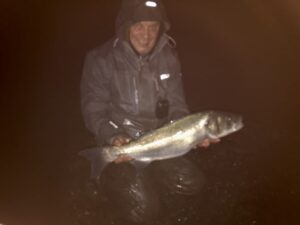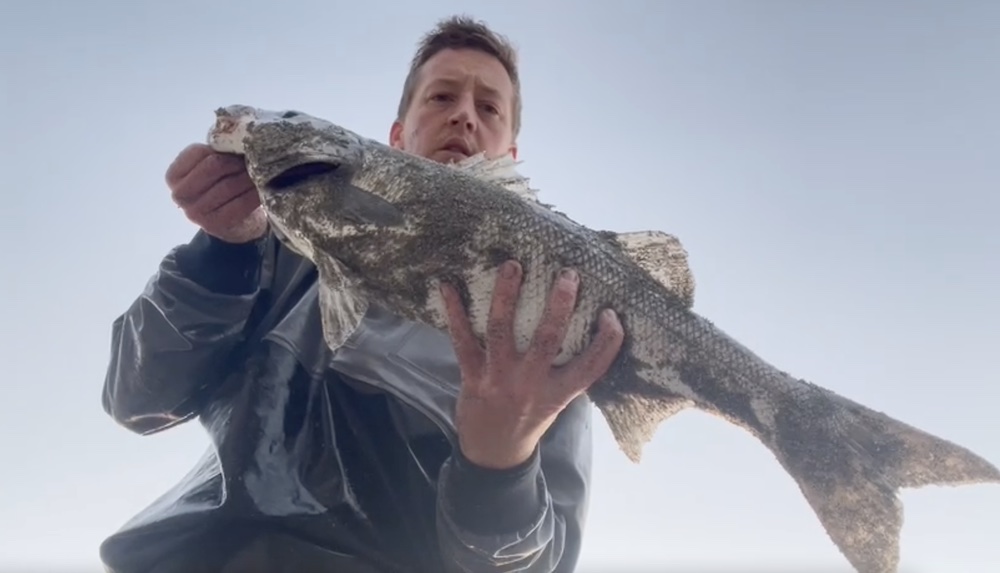It’s hard to find somewhere that isn’t blown out, weeded up or dirty! – at least on the South Coast. We seem to have had a run strong southerlies, just when I’ve traditionally had my best fish of the year.
In previous years this would have thrown a serious spanner in the works, but now I have other options – like estuary fishing. It was only last year that I switched onto this in a big way, and I still have much to learn, but my confidence is growing, along with my enjoyment.
Unfinished business
Those who have read my book A Bass Angler’s Life may recall that estuary fishing was the one area of bass fishing that I had yet to get to grips with. Other ‘unfinished business’ included catching bass on mackerel, both legered and free-lined.
It seems slightly ridiculous that I had never tried mackerel, but other baits – lug, sandeel, and then peeler crab, prawn, squid and finally razor, took precedence. A determined effort to correct this since the book was finished saw me legering frozen mackerel in the surf at night – and catching some quite nice fish.
It took fishing with Simon Willey for me to make the connection between using mackerel bait, specifically free-lining it, and fishing estuaries. With Simon’s coarse fishing background, this was a natural progression for him when he started targeting bass recently.
One of the things that had held me back from adopting free-lining for bass as a regular method was the requirement for calm conditions. Even in calm weather there is often some wave action on the coast, so the opportunities to use this technique are limited. Whereas in estuaries this is rarely a problem, especially if you can tuck in out of the wind somewhere.
Simon has put his limited time in bass fishing to good use. Through a combination of perseverance, hard graft and good angling, he has caught some good bass using big free-lined baits in estuaries. Like this cracking 68cm (7lb 2oz) fish taken on a whole squid (lots of squid around at the moment).

I’ve even managed to catch one myself. Only a modest 49cm, but great to finally do it, and get to experience the bite and subsequent run (although this was not as rapid as is usual). I love the simplicity of this method – braid main line (20+lb), bead, swivel, short 20lb Amnesia trace and 8/0 circle hook. No need for heavy gear either – just a 50g rated 9ft 6 lure rod and medium-sized spinning reel.
Mind you, you have to put up with other species grabbing your bait as well – like the inevitable huss (I’ve caught them to 12lb – if only that was a bass!), and conger.
Festival fishing
The weekend of 7th – 9th October saw me fishing the Cornish Lure Festival and the Tintagel Open Bass competition, which were both scheduled for the same weekend. It’s great to take part in these events and join in with other anglers. They make you do things you normally wouldn’t – like back to back sessions, early morning starts, and revisiting old favourite haunts that have produced good fish in the past.
The CLF is a regular in my fishing calendar, and this year’s event was bigger and better than ever. Alas the fish didn’t play their part, for although there were some good fish caught, like Johnny Jones’ superb 73cm winner which you can see in the featured image of this blog, most anglers struggled to catch the better fish. Although I caught bass on 3 of the 4 sessions I fished, I didn’t manage anything worth registering.
This was the first time I had entered the Tintagel comp. In recent years I have only fished catch and release competitions – not because I have anything against people keeping bass, provided they are over 42cm and they don’t take more than 2 a day (this changes to none at the end of this month), but because I don’t like taking fish for the sole reason of winning competition prizes. With Tintagel having made the switch to a catch and release format, I thought it was important to support them. All credit to the club for putting on a well organised event, which I hope they will repeat. This year’s comp was won by Simon Toms with a super 72cm (7lb 10oz) bait-caught fish. Simon is one of the top bass anglers in Cornwall, with many fine fish to his credit. His latest success comes hot on the heels of his winning performance in this year’s Camborne Bass Competition.

Walk the dog or walk the frog?
These days when using surface lures (sliders), everybody seems to ‘walk the dog’, but many years ago you kinda did your own thing.
One day, many years ago, I met Jon Hnat while out fishing. I noticed that Jon was working his lure (a 9cm Yozuri Arms Pencil – later rebranded as a Duel Silver Dog 90) in an unusual way – he would give one full turn of the (rather large) reel handle, pause, then give another turn. That can’t work I thought – until the water exploded as a bass slashed at his lure. I can honestly say that experience changed my fishing forever. I was absolutely hooked on surface lures, and now I knew how to work them.
I carried on using this technique, but the increasing popularity of ‘walking the dog’ made me wonder if I should change to this. I have, and do, use this method, especially if the fish are a bit finicky or lazy e.g. on neap tides, but the old technique still works fine – even with larger lures.
‘Walking the dog’ is usually done with medium-fast retrieve, resulting in a lure zig-zagging across the surface in quite an energetic way. To my mind this must look like a panic-stricken baitfish fleeing for it’s life – perfect for the lively young bucks to chase. Contrast that with the turn-stop-turn retrieve resulting in a lure which slowly and erratically wakes across the surface, imitating an injured or dying baitfish – an easy meal for large and canny females.
‘Turn-stop-turn’ doesn’t exactly roll off the tongue. Rather than the continuous movement which ‘walking the dog’ produces, this method results in the lure effectively skipping, or hopping forward. Which animal hops – frogs of course, so why not call it ‘walking the frog’ !
Water clarity
Something I’ve noticed while estuary fishing is that surface lures seem to work better when the water is clear. In coloured water I think soft plastics have the edge, especially white ones, although I hear that black ones are one better.
I recently read an excellent article by Alan Bulmer about how turbidity affects fish behaviour.
Some of important takeaways from this, for me at least, include:
- dark lures for contrast work well in murky water in medium to high light levels
- on dull days, try to find clearer areas, and fish the boundary between clear and coloured water
- try fishing slow and low in coloured water; use a high contrast paddle tail
- in estuaries, turbidity will be greatest on spring tides, especially the middle hours when tidal flow is greatest
Sonic fingerprint
Another takeaway from Alan’s article is that your soft plastic needs to have a distinct “sonic fingerprint” so that it can be detected by the fish.
One night a couple of weeks ago, I was using a ‘Dark Sleeper’ lure. If you’re not familiar with these, have a look at this amazing video (apologies to those who have already seen it, but it stands rewatching). First cast I had a bump, so I knew there were fish about, and they wanted this lure, just worked with a steady straight retrieve in the current. An enjoyable 45 minutes later I had landed 5 bass – nothing big (best was 50cm), but great fishing. If you see this lure in daylight, its small paddletail goes like the clappers, which must give it one helluva sonic fingerprint – no wonder it attracts bass.

The barbless dilemma
I use single hooks on all my plugs, but I’ve flipped back and forth between barbed and barbless. I switched to barbless in the interests of reducing damage to fish, since I release the vast majority of the ones I catch. This seemed to result in a number (perhaps 50%) of fish being lost in the final stages of the fight, when the fish thrash about.
Now I don’t catch that many fish that I can afford to lose 50% of them, so I decided to move back to barbed hooks. This resulted in a better hooking rate, without seemingly causing too much damage to the fish – until this happened:

On the day in question the fish seemed really fizzed up, smashing the surface virtually as soon as the plug touched down. Instead of getting lip-hooked, they were practically swallowing the plug right down. This made getting the barbed hooks out very difficult; although I managed to get the hook(s) out, I’m not sure how long the fish would have survived after initially swimming off.
I’ve gone back to barbless for the time being, while the fish seem to be feeding hard for winter. I guess I’ll just have to accept that I might lose a few fish – either that or carry plugs with both barbed and barbless hooks, and use either according to how the fish are taking the plug.
Tightlines, and thanks for reading,
![]()

